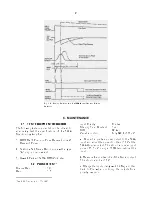
23
NOISE
Measurethenoiseat the amplifier Unipolar
output with maximum amplifier gain and 2 µs
shaping time. Using a true rms voltmeter, the noise
should be less than 5 µV x 1500 (gain), or 7.5 mV.
For an average responding voltmeter, the noise
reading would have to be multiplied by 1.13 to
calculate the rms noise. The input must be
terminatedin100
Ω
duringthenoisemeasurements
6.3. SUGGESTIONS FOR
TROUBLESHOOTING
In situations where the 572A is suspected of a
malfunction, it is essential to verify such
malfunction in terms of simple pulse generator
impulses at the input. The 572A must be
disconnected from its position in any system, and
routine diagnostic analysis performed with a test
pulse generator and an oscilloscope. It is
imperative that testing not be performed with a
source and detector until the amplifier performs
satisfactorily with the test pulse generator.
The testing instructions in Section 6.2 and the
circuit descriptions in Section 5 should provide
assistance in locating the region of trouble and
repairing the malfunction. The two side plates can
be completely removed from the module to enable
oscilloscope and voltmeter observations.
6.4. FACTORY REPAIR
This instrument can be returned to the ORTEC
factory for service and repair at a nominal cost. Our
standard procedure for repair ensures the same
quality control and checkout that are used for a
newinstrument.AlwayscontactCustomerServices
at ORTEC, (865) 482-4411, before sending in an
instrument for repair to obtain shipping instructions
and so that the required Return Authorization
Number can be assigned to the unit. This number
should be marked on the address label and on the
package to ensure prompt attention when the unit
reaches the factory.
6.5. TABULATED TEST POINT VOLTAGES
The voltages given in Table 6.1 are intended to
indicate typical dc levels that can be measured on
the printed circuit board. In some cases the circuit
will perform satisfactorily even though, due to
component tolerances, there may be some voltage
measurements that differ slightly from the listed
values. Therefore the tabulated values should not
be interpreted as absolute voltages but are
intended to serve as an aid in troubleshooting.
Table 6.1. Typical dc Voltages
Note: All voltages measured with no input signal,
with the input terminated in 100Ω, and all controls
set fully clockwise at maximum.
Location
Voltage
TP1
±5 mV
TP2
±30 mV
TP3
±20 mV
TP4
±20 mV
TP5
±30 mV
TP6
0 to +3.3 V
TP7
±6 mV
Q15E
-15 V ±0.8 V
Q16E
+15 V ±0.8 V
IC13 pin 2
+5 V ±0.3 V
Summary of Contents for 572A
Page 6: ...vi...


































